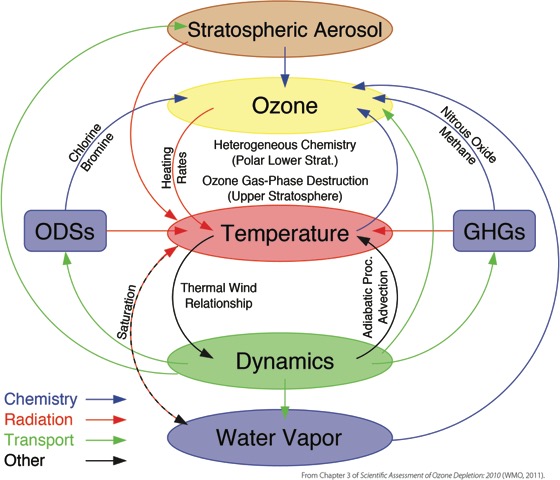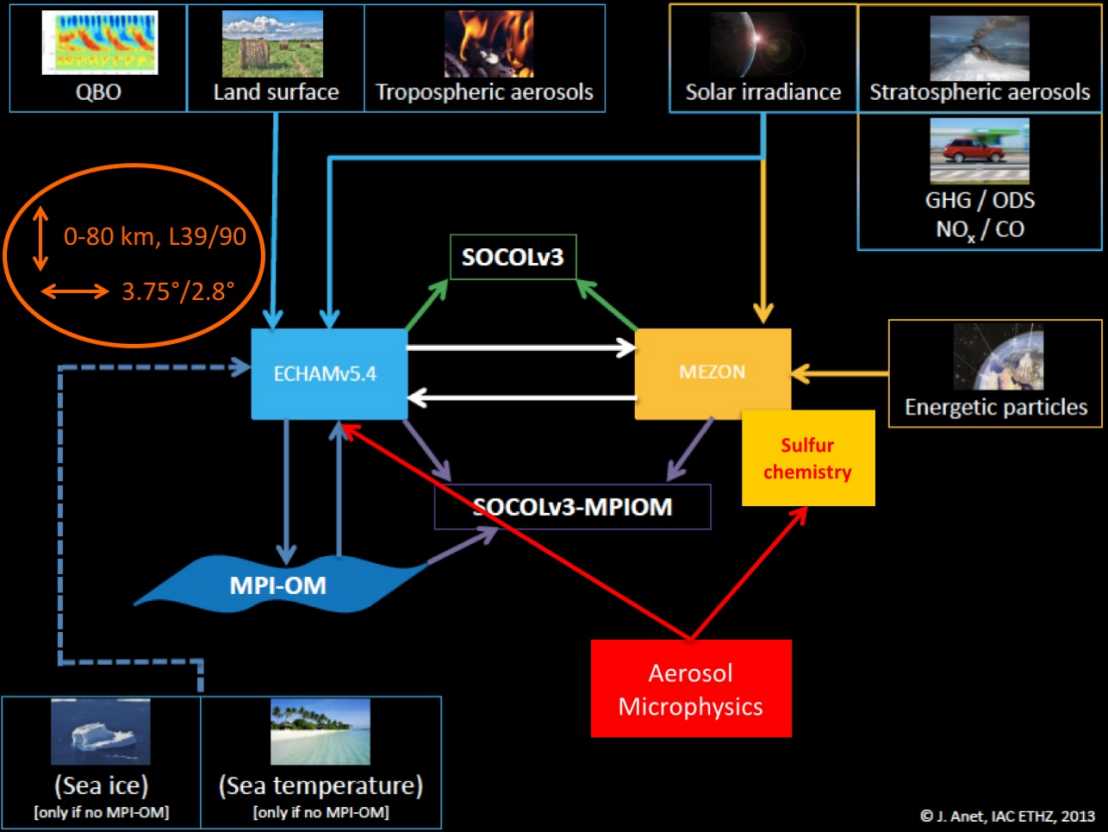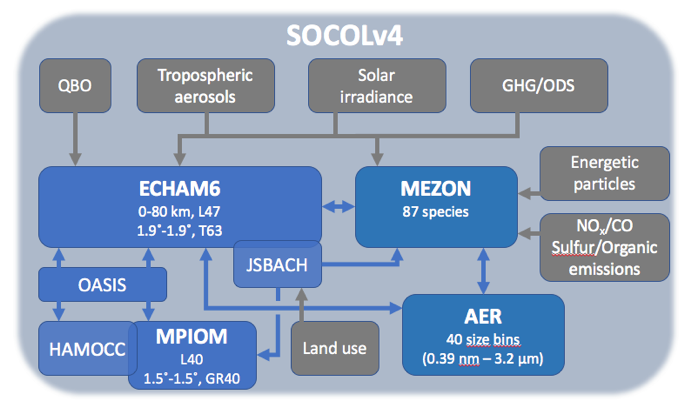Chemistry-Climate-Interactions

The Earth system consists of different components (e.g. atmosphere, oceans, land), which are coupled by physical, chemical and biological processes. Many changes, either natural or man-made, in the Earth system directly affect climate. Atmospheric chemistry plays a critical role in climate change by controlling the amount and distribution of important climate forcing agents like water vapor, methane or tropospheric and stratospheric ozone. However, the link between chemistry and climate goes both ways, and changes in the climate can influence atmospheric chemistry in several ways.
The Atmospheric Chemistry group uses the coupled chemistry-climate model SOCOL to investigate and understand the various complex interactions among the different components of the climate system, like the drivers of the interannual variability of atmospheric methane concentrations, the impact of solar irradiance on chemistry & climate, stratospheric and tropospheric ozone trends as well as stratospheric sulfate aerosols or the atmospheric cycle of Selenium, an essential trace element for humans and animals. Furthermore, we participate in international modeling activities like CCMI and work continuously on the further development and improvement of SOCOL. We are also exploring the impact of ozone on climate using SOCOL and other chemistry-climate models, as part of the SNSF Ambizione project TORSO.
Our SOCOL team:
Will Ball, Ari Feinberg, Tom Peter, external pageLaura Revell (University of Centerbury, NZ)call_made, external pageEugene Rozanov (WRC/PMOD Davos)call_made, Michael Steiner, Andrea Stenke, external pageTimofei Sukhodolov (WRC/PMOD Davos)call_made, Franziska Zilker, Gabriel Chiodo, Marina Friedel, Sandro Vattioni
Chemistry-Climate-Model SOCOLv3

SOCOL (SOlar Climate Ozone Links) is a comprehensive chemistry-climate model, covering the atmosphere from the Earth’s surface up to the mesosphere (about 80 km). The current SOCOL generation consists of the middle atmosphere version of the general circulation model (GCM) MA-ECHAM5 and a modified version of the UIUC (University of Illinois at Urbana-Champaign) atmospheric chemistry-transport model MEZON. The chemistry module covers stratospheric homogeneous and heterogeneous ozone chemistry and the most relevant chemical processes for describing the tropospheric background chemistry including an isoprene oxidation mechanism. SOCOL can be run at different horizontal resolutions (spectral truncation T31 or T42) and vertical levels (39 or 90). Depending on the application SOCOL can be run with prescribed sea surface temperatures, a mixed-layer or a deep ocean module or with the comprehensive sectional sulfate aerosol module AER (external pageSheng et al., 2015call_made). A detailed description and evaluation of the current model version SOCOLv3 is presented by external pageStenke et al. (2013)call_made and external pageRevell et al. (2015)call_made.
Atmosphere-Ocean-Aerosol-Chemistry-Climate-Model SOCOLv4

Since the publication of SOCOLv3 (external pageStenke et al., 2013call_made), the model has undergone further improvements, such as the addition of VOC chemistry, an interactive lightning NOx parameterization, upgraded schemes for solar heating rates, photolysis rates, and a parameterization of energetic particles. In close collaboration with other Swiss institutes we have added the ocean/sea-ice dynamics model. The performance of the atmosphere-ocean-chemistry-climate model (AOCCM) SOCOL-MPIOM in simulating past climate has been evaluated and documented in the framework of the SNF Sinergia project FUPSOL (external pageMuthers et al., 2014call_made). In the framework of the SNF project IASSA, we have extended the model by adding sulfur chemistry and aerosol microphysics. The performance of the new aerosol-chemistry-climate model (ACCM) SOCOL-AER was documented for background and high aerosol loading conditions, after which it has been further improved, among other things, by adding new dry and wet deposition schemes.
In a next step, we combined the multiple model versions into the fourth version of the SOCOL model within the framework of SNF project VEC. It is based on the combination of the MPI-Met (Hamburg, Germany) Earth System model consisting of the atmospheric component ECHAM6 and the ocean model MPIOM as well as JSBACH for the terrestrial biosphere and HAMOCC for ocean biogeochemistry, with the latest versions of chemical (MEZON) and microphysical (AER) modules. The model treats the majority of processes in the Earth system from the ground up to the mesopause. In addition to the interactive gas-phase/heterogeneous chemistry and bin-resolved stratospheric sulfate aerosol, the model can simulate dynamical vegetation, carbon cycle, emission of sulfur containing species from the ocean and other necessary quantities to simulate direct forcing and feedbacks responsible for the ozone and aerosol layer evolution. SOCOLv4 is already operational and undergoes currently a process of final tuning and verification.
